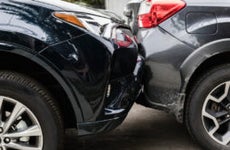What is a collision deductible waiver?

The Bankrate promise
At Bankrate, we strive to help you make smarter financial decisions. To help readers understand how insurance affects their finances, we have licensed insurance professionals on staff who have spent a combined 47 years in the auto, home and life insurance industries. While we adhere to strict , this post may contain references to products from our partners. Here's an explanation of . Our content is backed by Coverage.com, LLC, a licensed entity (NPN: 19966249). For more information, please see our .
Our writers and editors used an in-house natural language generation platform to assist with portions of this article, allowing them to focus on adding information that is uniquely helpful. The article was reviewed, fact-checked and edited by our editorial staff prior to publication.
Key takeaways
- A collision deductible waiver is an optional endorsement that can be added to a car insurance policy to cover your deductible in the event of an accident where you are not at fault.
- This waiver is not available in all states and may not cover all types of accidents, such as hit-and-runs or single-vehicle accidents.
- In California and Massachusetts, collision deductible waivers are state regulated, but in other states, insurance companies define what a collision deductible waiver is and how it may be applied.
Accidents happen, and sometimes they’re not your fault. When this happens, your collision coverage will pay to repair your vehicle but you are left paying for the collision deductible out-of-pocket. However, an optional feature some car insurance companies offer may help alleviate this burden – a collision deductible waiver (CDW). This waiver can pay for your deductible if you are involved in an accident, but its availability and coverage terms vary by state and insurance provider.
What is a collision deductible waiver?
A collision deductible waiver (CDW) is an optional feature you can add to your car insurance policy. It is an endorsement that covers your collision deductible when you are involved in an accident with an uninsured or underinsured driver. This type of endorsement is not available in every state or with every insurance company. Aside from California and Massachusetts, where the state regulates CDWs, insurance companies can choose if they want to offer this coverage, how it works and what it is called, which can lead to some confusion.
How does a collision deductible waiver work?
How a collision deductible waiver works and when it applies depends on the guidelines set by your insurance company. That said, there are some common restrictions that most companies follow:
- Actual cash value (ACV): The ACV of your vehicle must be more than the amount of your deductible.
- Fault determination: Most insurers require you to be not at fault for the accident. Some auto companies may require you to be 100 percent fault-free to have the deductible waived, while others may waive a percent of your deductible based on your percentage of fault.
- Driver identification: The at-fault driver typically needs to be identified and found uninsured. If the driver is unidentified, the coverage will not apply, and if they are identified and have insurance, their property damage coverage will pay for your vehicle repairs.
Collision deductible waiver in California
In California, collision deductible waivers are called California deductible waivers. California Insurance Code requires insurance companies to offer policyholders a CDW if they have both collision coverage and uninsured motorist bodily injury coverage (UMBI) on their policy. California requires insurance companies to offer uninsured motorist property damage (UMPD) coverage to all policyholders who do not have collision coverage but allows policyholders to reject this coverage in writing. However, UMPD coverage in California does not have a deductible, and collision and UMPD can not be carried simultaneously on the same car. Therefore, this waiver allows policyholders to have the benefit of not paying a deductible if their vehicle is damaged by an uninsured driver.
If the policyholder is involved in a hit-and-run where the at-fault driver is not found, they will have to pay their collision deductible. For California drivers who opt for UMPD on top of liability-only coverage, the UMPD coverage limit is a fixed amount of $3,500.
Collision deductible waiver in Massachusetts
In the state of Massachusetts, CDW is an optional endorsement that allows the collision deductible to be waived if the policyholder is involved in an accident caused by an identifiable driver who is uninsured. If the driver is not identifiable, the policyholder will need to pay their collision deductible. While the CDW for California and Massachusetts seem similar, the main difference is that UMPD is not an option in Massachusetts.
Alternatives to collision deductible waivers
Even a low deductible can be a significant out-of-pocket expense, especially if you have to pay it unexpectedly. If you don’t have the option of a CDW or choose not to have one, here are some alternatives that might help you save on deductible expenses:
Diminishing or vanishing deductible
Many insurance companies offer these options as either an additional endorsement you can pay extra for or as a policy benefit to preferred drivers. Once you select a deductible amount, the deductible is reduced over a certain period of time and as long as you stay incident-free. For example, if you select a $500 collision deductible, you may see a $100 decrease in your deductible every year you go without an accident. The length of time and amount of reduction is determined by the carrier.
Uninsured motorist collision deductible waiver
An uninsured motorist collision deductible waiver is very similar to a CDW. If you are involved in a car accident with an identified driver and this driver is at fault for the accident, your insurance company will waive the collision deductible. Again, the specifics surrounding this coverage will depend on your insurance provider, but you usually have to pay extra for this waiver.
Uninsured motorist property damage
UMPD provides coverage for your vehicle and property when it is damaged by an uninsured driver. It essentially acts as a replacement for the property damage liability coverage the at-fault driver should have had. UMPD availability, coverage and deductible options vary between states and carriers.
Choose a low deductible
The most common collision deductible is between $500 and $1,000, but you may have lower options depending on your carrier. Some companies offer collision deductibles as low as $100, and comprehensive deductibles can be as low as $50 or zero. While lowering your deductible will increase your premium, drivers with older cars might not see a significant change.
Is a collision deductible waiver the same as uninsured motorist coverage?
Collision deductible waiver and uninsured motorist coverage are not the same. The CDW, usually an optional add-on, waives your collision deductible in the event of a claim against an uninsured motorist. Uninsured motorist is a type of liability coverage that can pay for repairs and medical payments for you and your passengers caused by an uninsured driver.
Uninsured motorist bodily injury (UMBI) usually only pays for medical expenses, and UMPD is a separate coverage for physical damage loss. However, some states have UM coverage that combines both coverage types, and some states don’t allow for UMPD coverage at all.
If your insurance company or state doesn’t offer a CDW, UMPD may be a good alternative. Uninsured driving is on the rise, and this coverage usually has a lower premium and deductible than collision coverage. This may be helpful for drivers looking to save money on car insurance while retaining some form of physical damage coverage. See the table below for state-specific UMPD coverage.
States with mandatory UMPD
| State | Minimum UMPD limit | Mandatory deductible |
|---|---|---|
| Maryland | $15,000 | $250 |
| North Carolina | $25,000 | N/A |
| South Carolina | $25,000 | $200 |
| Vermont | $10,000 | $150 |
| Virginia | $20,000 | $200 – hit-and-run |
| West Virginia | $25,000 | $300 |
| Washington, D.C. | $5,000 | $200 |
States with optional UMPD
| State | UMPD limit | Mandatory deductible |
|---|---|---|
| Alaska | Various options | $250 |
| Arkansas | Various options | $250 |
| California | $3,500 per accident limit | N/A |
| Delaware | Various options | $250 |
| Georgia | Various options | Optional |
| Indiana | Various options | $300 |
| Illinois | Various options | $250 |
| Louisiana | $10,000 only | $250 |
| Mississippi | Various options | $200 |
| New Jersey | Various options | $500 |
| New Mexico | Various options | $250 |
| Ohio | $7,500 | $250 |
| Rhode Island | Various options | $200 |
| Tennessee | Various options | $200 |
| Texas | Various options | $250 |
| Utah | $3,500 only | $250 |
| Washington | Various options | $300 hit-and-run $100 all other incidents |
| Wyoming | Various options | N/A |
Pros and cons of a collision deductible waiver
Opting for a collision deductible waiver could be a financial safeguard in the event you are hit by an uninsured driver, but it’s crucial to consider both its advantages and potential downsides.

CDW Pros
- It might spare you the expense of your collision deductible if an uninsured driver causes an accident
- The endorsement cost is generally low compared to the cost of a collision deductible
- In specific states such as Massachusetts and California, distinct versions of the waiver may apply even in certain hit-and-run cases

CDW Cons
- Additional coverage can increase your car insurance rates
- It doesn't deliver new coverage; it simply eliminates the deductible under certain circumstances
- Deductibles still need to be paid in scenarios that fall outside the waiver's domain, like accidents involving only your car or cases where another driver isn't deemed responsible
Frequently asked questions
-
-
A CDW is optional, so you only need it if you think it will be beneficial for you. If you have a high deductible or live in an area with a high percentage of uninsured drivers, it may be worth considering. UMPD coverage is another affordable option that provides coverage if you are hit by an uninsured driver. The best course of action is to contact your insurance agent to see what options will fit your budget and coverage needs.
-
The cost of a CDW will depend on the carrier, the amount of your deductible and your overall policy and driving profile. If you want to purchase a CDW, your insurance agent can quote you the cost to add this to your policy.
-
These two coverage types sound very similar, but they apply to different types of auto insurance policies. A collision deductible waiver is an add-on to your personal auto insurance that covers your deductible if an uninsured driver causes an accident. A collision damage waiver is offered by rental car companies to cover repair costs if their vehicle is damaged in a crash.
-
Related Articles



